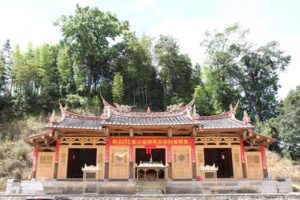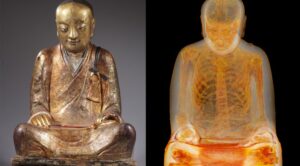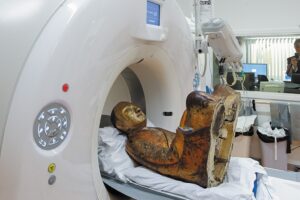
Temple in Yangchun where the statue was originally housed. Photo copyright: Lin Wenqing
Last month, the Sanming Intermediate People’s Court of Fujian Province, China announced that the residents of the Yangchun and Dongpu villages had a proprietary right in a Buddha containing the mummified remains of a 1,000-year-old monk. The court ordered its return from Dutch art collector Oscar van Overeem. As one might expect, the story of how this treasured cultural artifact traveled to the Netherlands, and how a civil court might reach such a verdict, has been anything but conventional.
During the Song Dynasty (960-1297), a Buddhist monk named Zhang Gong Liu Quan was a skilled doctor known for his benevolence. In fact, he was credited with helping the local population to survive a plague. He was said to have achieved Nirvana, and in the later years of his life, he prepared his body for self-mumification. Following his death, Zhang Gong’s mummified remains were enclosed in a golden Buddha statue to commemorate his contributions to the community. Thereafter, the practice of worshipping the statue, the Zhanggong Zushi (also called Buddha Zhanggong), has been passed down for almost a thousand years through generations of the local population.
That statue is adorned with elaborate ornamentation representative of the Ming Dynasty, which is consistent with the last time the piece was renovated. The seated Buddha wears two sets of robes: a grey lining covered by a delicately carved outer layer. The outer layer features an intricate network of clouds, knitted lines, and flowers. Accorind to Erick Bruijn, an independent researcher of esoteric Buddhism, the right sleeve and stomach area depict dragons to evoke longevity and “irresistible power.” A black belt is draped over the left shoulder with ends on the left chest and back. The back is also decorated with the Chinese character “佛,” for Buddha. The statute wears a philosophy ring on its left hand surrounded by inscriptions noting “disasters turning into auspicious” and “delivering all living creatures from torment.” According to local records, the piece was renovated in an effort to reverse population decline in the area and bring the people a successful harvest.

Photo owned by Drents Museum
The statue remained in the small village of Yangchun since Zhang Gong’s mummification. There, worship of the statue continued for generations despite a long and sometimes turbulent history. Once, the piece was even buried in a field to avoid destruction during China’s Cultural Revolution. However, the piece went missing in December 1995, when it was stolen and smuggled to Hong Kong. Locals from Yangchun reportedly saw a van traveling through the tiny village where the statue was housed. In the rear seat, they saw a seated figure covered with a blanket, and they assumed it was someone who was ill being taken for medical treatment. Shortly afterwards, they discovered that the statue of the holy man was missing from the temple. Locals were devastated. As stated by one villager, “Zhang Quisan is not a cultural relic…We see him as family. He is one of us.”
Unbeknownst to the villagers, on the other side of the world, the statue appeared for sale. The statute was lost until it was sent to Asian art and antiquities restorer, Carel Kools, who later purchased it in 1997. Upon further testing, Kools was shocked to discover the statue contained a set of mummified remains, although he remained unaware of the subject’s identity. He then sold the work to Oscar van Overeem, an Amsterdam-based architect and respected art collector. The local villagers learned of the statue’s location while it was on loan to the Hungarian National History Museum in 2015.
The two villages demanded the return of the statute and the remains. After negotiations between the villages and Overeem yielded negligible results, the two villages sought to recover the statue through the Netherlands courts. Overeem argued that the “village committee is not to be referred to as a natural person or legal person” under Dutch law and therefore the court was not entitled to hear their claims. The villages responded in kind that under Chinese law, a village committee has standing to act as a party to litigation as a special legal person acting on behalf of village residents, and that such cases are not uncommon in practice.

Photo courtesy of The Economist
The villages also asserted that the object was properly understood to be a “corpse,” as defined under the Dutch Burials and Creations Act, and according to the Act, could not be subject to ownership. They emphasized that the act of mummification was intentional, and “[t]he likely wish of monk Zhang Gong is that through mummification, he would after his death continue to have a spiritual and healing power on his environment, and he would certainly not have agreed that his body would become the subject of (illegal) art trade.” Overeem argued that because most of the organs were absent, the mummy was better classified as “human remains” and not a corpse, drawing on literature supporting the practice of auctioning mummies throughout the U.S., Canada, Britain, and beyond. There were also doubts presented as to whether this was truly the correct Buddha in question and whether Overeem exercised good faith when he purchased the work back in 1995. The villages argued that Hong Kong had a reputation for illegally sourced antiquities at the time, and as a seasoned collector, Overeem should have known to make more detailed inquiries into the work’s provenance and provenience. Under the Dutch Civil Code, collectors must observe necessary prudence when acquiring ancient cultural objects. It is known within “professional art trading circles” that this kind of statue could never have been legally exported from China without a permit. A major collector should have asked for provenance documents and an export permit. Apparently, Overeem did not.
The Dutch case was dismissed in 2018, when the court ruled that the committees were not legal persons (leaving other, more visceral questions for a later date). The villages continued their pursuit, however, in China. In a decision issued last month, the Chinese Court sided with the plaintiffs and ordered Overeem to return the statue within 30 days. Overeem has said separately that he already sold the statue to a Chinese businessman, and that he no longer has any knowledge of its whereabouts. What will happen if and when Overeem does not comply with the Chinese court order is unclear.
The case highlights a change in China’s official policy towards cultural artifacts, in which the nation has begun to demand and litigate for the restitution of looted objects. The mummy is said to have become a smaller Chinese version of the Elgin marbles: an emblem of the despoliation of Chinese culture by foreigners. Unfortunately for many nations around the world, a vast number of significant cultural items are not in secure locations, and thus are vulnerable to falling victim to illicit removal.